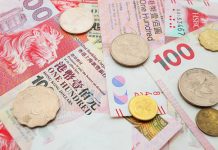‘Additional evidence of persistently above-trend growth, or that tightness in the labour market is no longer easing, could put further progress on inflation at risk and could warrant further tightening of the monetary policy’ said the Federal Reserve (Fed) Chair Jerome Powell at the Economic Club of New York yesterday. September’s 336K NFP read, higher-than-expected set of inflation data at the latest release contrary, a more than 35% surge in US household net worth since 2019 (Survey of Consumer Finances) are among evidence that the US economy is doing just fine.
Of course, the flip side of the story is dirtier. The US national debt is now above $33 trillion and rising and the safety of the US sovereign bonds, especially on the long end of the yield curve, came under scrutiny by global investors. Despite the rising tensions in Gaza, and a swift flight to safety, the US 10-year papers were aggressively sold, and the US 10-year yield hit the 5% mark after rising by around 35bp since Monday.
The selloff could be explained by strong retail sales data – that followed a strong NFP read and a stronger-than-expected inflation data since the month started – which both fueled the hawkish Fed expectations.
While a hawkish Fed means higher rates and the continuation of the QT, the US Treasury issues long-term debt to balance out the amount of short-term bills that it issued earlier this year.
Moreover, the US is now expected to help Israel – and continue to help Ukraine, in a period of swelling fiscal problems.
Whatever it is, the US initial jobless claims yesterday came below the 200K psychological level, and further fueled the selloff. The US 10-year yield at 5% for the first time since 2007. Needless to tell you that this is the first time in my career I have seen the US 10-year yield at this level as I had my Master’s degree in 2010! The US 2-year yield remains steady around 5.15%. The gap between the US 2 and 10-year yield is now narrowing, we haven’t seen recession in the US just yet. Bloomberg’s Simon White writes that there is ‘sufficiently compelling evidence that the US – and the rest of the world – is likely to enjoy a cyclical upswing before the next downturn’. I am less optimistic. The US 10-year yield at 5% will likely boost appetite, if not, expect the stock markets to bear the brunt of the surge in long term yields.
In the FX, the US dollar is surprisingly calm this week; you would expect more movement amid the surge in the US yields. Regardless of surging US yields, safe haven capital flows into gold. The price of an ounce exceeded $1980 this morning, and the purchases should accelerate before the closing bell as investors will seek safety into a weekend that could bring more carnage in the Middle East. Crude oil is above the $90pb level and has more to rise due to fear of supply disruptions in the Middle East. The dollar-yen is uncomfortably stable near the 150 psychological mark, as inflation in Japan came in higher-than-expected but fell to a year low, softening the Bank of Japan (BoJ) hawks’ hands.













